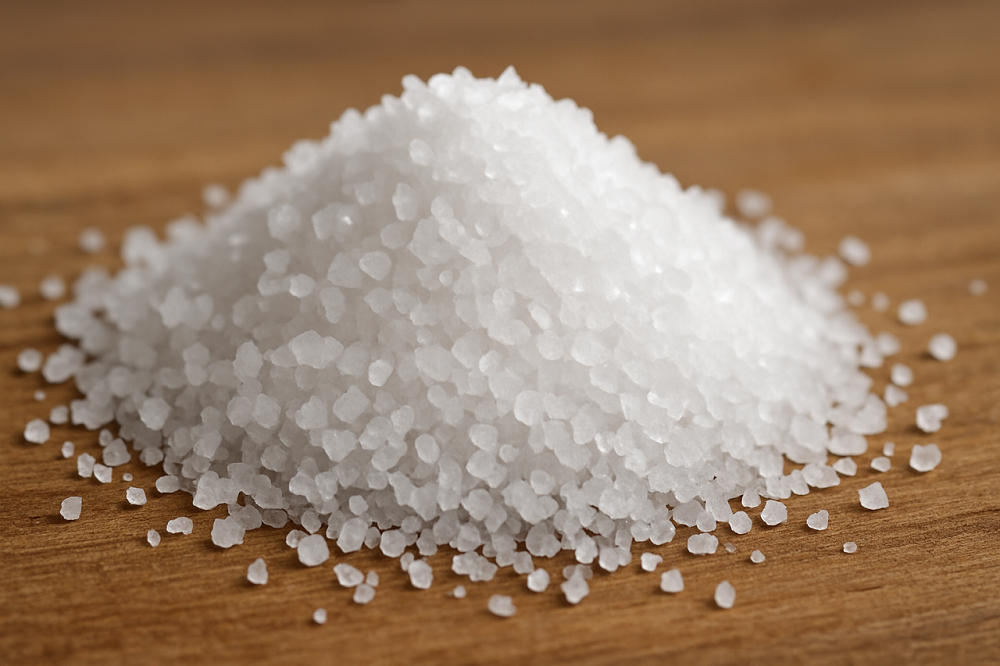Why Sodium Chloride Is a Must-Have Ingredient in Hand Wash: Importance & Benefits

বাংলা পোস্ট
Ever wondered what makes your hand wash feel just right — not too runny, not too thick, and foamy enough to make your hands squeaky clean? The answer might surprise you. One of the most underrated but essential ingredients hiding in plain sight is Sodium Chloride — yes, the good old salt you sprinkle on your fries.
But don’t let its kitchen identity fool you. In the world of cosmetics and personal care products, Sodium Chloride is a silent superhero. From thickening to stabilizing, this simple compound plays a BIG role in how your favorite hand wash feels and functions.
Let’s dive into the salty science and see why Sodium Chloride is not just necessary, but kind of awesome.
What Is Sodium Chloride?
Sodium Chloride (NaCl) is a naturally occurring compound made up of sodium (Na) and chloride (Cl) ions. Commonly known as table salt, it’s one of the most abundant and versatile ingredients used not just in food, but also in pharmaceuticals, cosmetics, and skincare products.
When it comes to hand wash formulation, Sodium Chloride acts as more than just a filler. It serves multiple functional purposes that directly affect the texture, usability, and performance of the product.
Why Sodium Chloride Is Important in Hand Wash Formulation
1. 🧴 It Helps Control Viscosity (Thickening Agent)
Let’s be real — nobody wants a hand wash that’s runnier than soup. One of Sodium Chloride’s key roles is as a viscosity modifier, meaning it helps make the product thicker and creamier. This not only improves the texture but also gives you better control when you pump it onto your hands.
Without it, your hand wash might feel too watery and drip away before it can do any cleaning.
Fun Fact: Just a pinch of Sodium Chloride can turn a thin liquid into a satisfyingly thick gel. Magic? Nope. Just chemistry.
2. 🫧 Boosts Foaming Action
You know that satisfying lather when you rub your hands together? Sodium Chloride helps make that happen by enhancing the performance of surfactants (like Sodium Laureth Sulfate or Cocamidopropyl Betaine), which are the actual cleansing agents.
More foam doesn’t always mean cleaner hands, but it improves user experience by making it feel like the product is working harder.
3. 🔬 Acts as a Stabilizer
Sodium Chloride also works behind the scenes to keep the formula stable. That means it helps other ingredients blend better and stay mixed over time, especially in liquid-based formulations.
No one likes a hand wash where the liquid separates or looks weird after a few weeks on the shelf, right?
4. 💸 Cost-Effective and Efficient
Let’s not ignore the economics. Sodium Chloride is affordable, accessible, and easy to work with. This makes it a favorite for manufacturers looking to create budget-friendly products without compromising on performance.
In short: Big results, small cost.
5. 🌿 Safe for Skin (In Moderation)
Despite being called “salt,” Sodium Chloride is generally non-toxic and safe for topical use. In recommended amounts, it doesn’t cause irritation and works well with other skin-friendly ingredients.
However, using too much of it can make the product overly drying — which is why professional formulators balance it carefully in their recipes.
Benefits of Using Sodium Chloride in Hand Wash
Let’s sum up the direct benefits:
| Benefit | Why It Matters |
|---|---|
| ✅ Improves texture | Makes hand wash easy to apply and control |
| ✅ Enhances foam | Gives a satisfying clean feeling |
| ✅ Stabilizes formula | Ensures product consistency over time |
| ✅ Low cost | Keeps the product affordable |
| ✅ Generally safe | Minimal risk of skin irritation |
How Much Sodium Chloride Is Used in Hand Wash?
Typically, hand wash formulations include 1% to 5% Sodium Chloride depending on the desired thickness and surfactant blend. More than that can cause cloudiness or precipitation in the formula.
So yeah, it’s a bit of a science experiment — and the balance has to be just right.
Can Hand Wash Be Made Without Sodium Chloride?
Technically? Yes.
Practically? It’s tricky.
Without Sodium Chloride, hand wash may be too thin, less foamy, or unstable over time. There are alternative thickeners (like xanthan gum or cellulose derivatives), but they are often more expensive and harder to work with.
So while it’s possible, Sodium Chloride remains a reliable, effective, and budget-friendly choice.
How to Know If Your Hand Wash Contains Sodium Chloride
It’s easy — just flip the bottle and read the ingredients list. If you see “Sodium Chloride” listed (usually midway through the list), it’s in there doing its job.
Some brands might label it under INCI (International Nomenclature of Cosmetic Ingredients), but “Sodium Chloride” is the standard term across the board.
Natural vs. Refined Sodium Chloride: Is There a Difference?
Yes — but not always in the way you think.
-
Refined Sodium Chloride (used in cosmetics) is purified and free from heavy metals or impurities.
-
Natural or Sea Salt may contain trace minerals, which could interfere with product stability.
In most hand wash products, refined cosmetic-grade Sodium Chloride is preferred for its purity, consistency, and safety.
Final Thoughts: The Unsung Hero of Your Hand Wash
You probably never thought a pinch of salt could do so much. From helping your hand wash stay thick and lathery to stabilizing the whole formula and keeping your costs low — Sodium Chloride truly is an MVP.
Next time you wash your hands, give a little nod to this quiet overachiever.
Have you ever tried making your own hand wash or skincare products? Or are you curious about how to formulate one at home? Drop a comment below — I’d love to hear your experience!
And if you found this helpful, feel free to share it with someone who geeks out on cosmetic chemistry like we just did 😄
